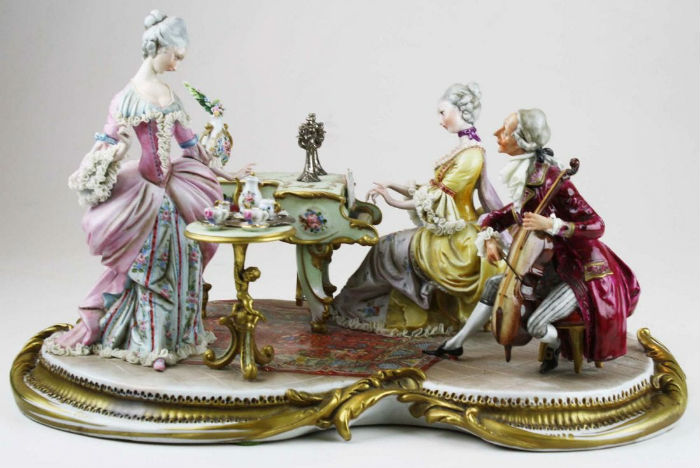
NEW YORK – Capodimonte porcelain was born of secrecy, love and passion.
In 1738, the height of the porcelain craze, Bourbon King Charles VII of Naples and Sicily wed Maria Amalia of Saxony, whose grandfather founded Meissen, the first hard-paste porcelain factory in Europe. Its secret formula replicated the strength, fragility, translucence and heat-resistance of imported china. Yet amazingly, this “white gold” also allowed extravagant enameling, gilding and glazing.
On receiving a dowry of multiple Meissen tea and dinner services, the bridegroom, captivated by their beauty, vowed to create porcelain of his own. After he located suitable kaolin deposits, unearthed trade secrets and hired experienced workers, his master chemist, Gaetano Schepers, perfected a superior, easily workable soft paste formula. Although inspired by Meissen porcelain, his lustrous results glowed with a warmer, creamier glaze.
In 1743, the delighted young couple founded the Royal Capodimonte (“Top of the Mountain”) Manufactory on the grounds of their palace. Initially, it produced small, fine, easily fired pieces including wall plaques, tea caddies, trinket boxes, sugar bowls, snuffboxes, beakers and spirit-barrels. Most, featuring bright scenic, animal, fruit, and flower reliefs, were unmarked or bore images of the blue or gold Bourbon fleur-de-lis.

Capodimonte’s street vender, mouse catcher, eel seller, rabbit hunter and dancing girl figurines, often molded by Guiseppe Gricci, were charmers. So were his portrayals of Italian commedia dell’arte characters, like Columbine, Pulcinella and Pantalone. Many of these feature heads small in proportion to their bodies. The company created exquisitely detailed, delicately tinted, hand wrought porcelain flowers and floral baskets.
In time, Capodimonte also produced prestigious chandeliers and “porcelain rooms,” coveted by European nobles and royalty. Yet many consider the shimmering creation that Charles commissioned for his bride, featuring a massive porcelain chandelier, decorative French mirrors, and lined with thousands of gilded porcelain plaques depicting chinoiserie reliefs, his crowning achievement. Today, this glorious chamber (minus its original porcelain floor) resides in the Capodimonte Museum in Naples.

Production ceased at Capodimonte in 1759, when Charles VII inherited the Spanish throne, becoming Charles III, King of Spain. When he transported key artists, workers, molds, models, equipment, as well as tons of clay to his new realm, he ordered everything left behind destroyed, lest it reveal secrets of his success. A similar factory, which he established near Madrid, eventually switched to hard paste, utilitarian products for everyday use.
In the meantime, Charles’ son Ferdinand IV inherited both his father’s throne and his passion for porcelain. In 1771, though barely out of his teens, he established the Naples Royal Porcelain Manufactory at the Royal Villa at Portici, acquiring porcelain samples and equipment used in the original factory. Through extensive experimentation, his team replicated his father’s unique Capodimonte soft paste porcelain formula. In the opinion of many, they created the finest, most collectible porcelain ever known in Europe.

Ferdinand generally followed former Capodimonte shapes and styles. Rather than feature pastoral or natural motifs, however, his vases, lamps, dinner sets, and decorative elements depict Neo-classical themes or celebrate recent archeological excavations. His marble-like biscuit busts and sculptures, masterfully wrought in unglazed, pure white porcelain, earned great acclaim. So did his detailed figurines which realistically reflected life in the Royal Court. Like other fine porcelain manufacturers, Ferdinand also practiced “porcelain diplomacy,” bestowing distinctive dinner services to notables and royalty across Europe. Yet after Napoleon occupied Naples in 1806, Capodimonte production once again drew to a close.

Today, most rare, delicate, exceedingly collectible Charles and Ferdinand-era porcelains are held in museums or in private collections. Those that reach the market command premium prices.
In the 1830s, the Doccia Porcelain Works (founded by Carlo Ginori) purchased the remains of Ferdinand’s factory, retaining its historic trademark. Decades later, Doccia-Ginori merged with the Richard Company, creating Capodimonte-inspired works known as Ginori or Richard Ginori. By the mid-century, other private porcelain works, including Mollica and Majello, were producing similar wares. Due to great popularity, copies and forgeries followed. Many are labeled “Capodimonte,” “in the Capodimonte style,” or bear their characteristic motifs, high relief, and flamboyant gilding. Yet these vary widely in form, style, craftsmanship and value. Furthermore, since original Capodimonte trademarks were not fully protected, many of these pieces bear misleading identification. Some may not even be true porcelain.

Today, select porcelain works in Naples, Milan and Venice continue the Capodimonte tradition of beauty and excellence. Their vases, clocks, candlesticks, wedding favors, centerpieces and holiday decorations – often adorned with applied, handcrafted flowers – not only evoke glories of the past, they also reflect contemporary humor and creativity.


